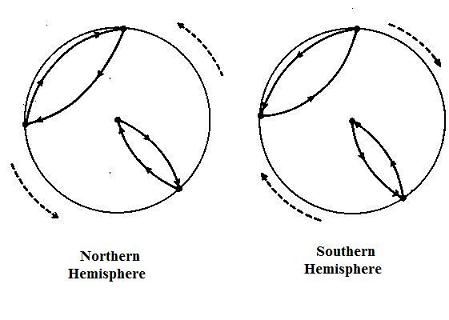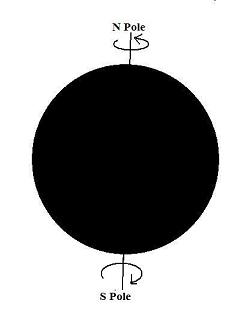About this page
An explanation of how the Coriolis effect causes winds to blow (more or less) along isobars and not across them.
Related pages
- How pressure differences are forme
- Sea breezes
- How the sun's heat gets into the atmosphere
- Latent Heat
To understand just how the Coriolis effect works is a three stage thought process.
A flat earth
Think, first of a flat earth – eg a roundabout spinning anticlockwise, like the earth when viewed from above the North Pole. Then, spinning clockwise, as the earth when viewed from over the South Pole.
If a ball is thrown to another person on the roundabout, trajectories will be as shown here. These are relative to the roundabout, ie as seen by someone standing on the roundabout.
The ball is deflected to the right in the first case and to the left in the second... The faster the spin, the greater is the deflection, the slower the less is the deflection. Click for a nice demo.
Or this nice real life demo of a ball being thrown across a roundabout to someone on the ground, and as seen by someone on the roundabout. Provided by provided by Duncan Wells of WeatView Sailing
A rotating earth
The next stage is to see what happens on a spherical earth. Standing on the North Pole, you would be spinning on your axis in an anticlockwise direction. Standing on the South Pole, you would spin clockwise. Looking straight ahead and trying to keep a star in sight you would have to turn your head as the earth was spinning.
Now stand on the equator, look due east and try to keep a star in sight. You would have to tilt your head backwards with no spinning or turning at all. As you move away from the equator you have to turn your head more and more but tilt it less and less until at the pole.
What all this means is that the deflection effect of the spinning earth is small right near the equator but rapidly increases as you move poleward. By 10° N/S, the spin is about 20% of the value at the poles. This is sufficient for hurricane formation. Few form nearer the equator than 10° N/S.
Finally
The final stage is to explain why the wind moves nearly along the isobars (except in very low latitudes). Basically, this is a result of the speed of spin of the earth. If the earth slowed down, then air would move more across the isobars; lows and highs would not last for long.


